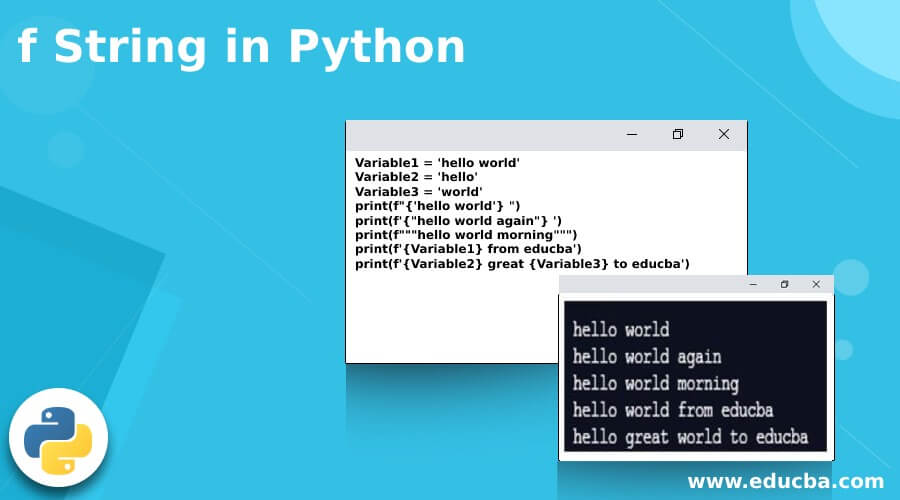Updated April 1, 2023
Introduction to f String in Python
The following article provides an outline for f String in Python. The f strings were introduced by PEP498. The PEP498 represents literal string interpolation. There are different ways strings can be formatted, this f strings are a technique among them. These different techniques include percentage formatting, using the format() method for formatting the string etc. Similar like this, the PEP498 is also a formatting mechanism introduced. The f strings actually expand as formatted strings. PEP kind of techniques allows to sophisticatedly insert new expressions into existing string literals using less amount of syntax involved. This is a key advantage of f strings.
The f sting expressions will be evaluated only at the run time of the string execution. Here expression insertion into an existing string is very easily performed without a very large amount of coding. The rationale method of formatting strings is largely prone to error, and more importantly, the rational techniques are hectic and cumbersome. These difficulties are largely reduced by using the formatted string technique of string handling.
Syntax of f String in Python
Given below is the syntax mentioned:
F’actaual_string_Expression#1 . . . {embedded expression} . . . actaual_string_Expression#n’In the above syntax, the method of introducing these embedded expressions within an authentic expression is expressed. This process involves starting the string expression, which is expected to be embedded within a below item, f’’. So, the actual string is expected to be placed within it. The string formation using PEP498 can be activated only by means of this f‘‘ string values. This is the key representation of the f string process. Then the expression which is expected to be embedded will need to be placed within the open and close braces. Mostly these embedded values are expected to be as variables.
So, the name of the variable will be expected to be placed within the open and close braces. In case, instead of the variable names, if an embedded expression is expected, then the embedded expressions are also expected to be placed within the expressions. So, wherever the string format change is needed can be maintained within this syntax, and this will be enough to attain the needed result. This is the key advantage of python f strings introduced in PEP498.
Key Points of f Strings
- In f strings, the literals of the string can be prefixed with both the lower case f and upper case F. Both these prefixes work as expected.
- When more than one line, which means several lines of the string expressions, are expected to be embedded with the f string formulation, then the prefix value of f string needs to be placed in front of each and every line in the string expression. So placing only one specific f prefix for multiple lines will not work in an expected manner. When only a single f prefix is placed, then the system will directly dump the expression embedded into the console. Whereas when each of the lines involved is embedded, then the expected output will be attained.
- When comparing to other rational manners of formatting like percentage-based string formatting or use of format() method for string formatting, it needs to be noticed that this technique of f string-based string formatting is the most fastest manner for formatting the string given. So, when considering the pace of formatting, this technique needs to be considered as the best one. This makes the f string formatting the best method for formatting the string values. One among the key reasons for this faster processing of f strings is because of the ability to perform the operation at the run time.
- More than one type of quotation marks can be used in the s strings, double quotes can be used, single quotes can be used, and even triple quotes can be used within the expression. All these quotes work very perfectly with the f strings. The only thing that needs to be ensured is whenever one specific quotation is opened up, then the same type of quotation is closed in the other end of the string is a key element to be considered. So every quotation which is opened need to be ensured to be closed, else it will throw an error at the time of execution. with maintain this condition furtherly, any type of quotations can be used within.
- Only during the run time execution of the code, the f strings will be evaluated. So, this provides the possibility for embedding even complex expressions within the f strings. Moreover, any kind of expression in python can be flexibly embedded within the f strings syntax values.
Example of f String in Python
Given below is the example mentioned:
Code:
Variable1 = 'hello world'
Variable2 = 'hello'
Variable3 = 'world'
print(f"{'hello world'} ")
print(f'{"hello world again"} ')
print(f"""hello world morning""")
print(f'{Variable1} from educba')
print(f'{Variable2} great {Variable3} to educba')Output:
Explanation:
- In the above given example, more than one form of string format is explained. First, the f string formatting is performed by means of a double quotation within a single quotation combination. Further, the embedded string is placed within a single quotation on the outside and a double quotation from the inside. From there on, an example of using hello world such that triple quotation is used and the embedded values are placed within it.
- Next, an embedded variable is used for f string formatting. The embedded variable is placed within an existing string expression. Lastly, more than one f string expression is placed together. So five different ways of performing this f string operation are expressed in the above examples.
Conclusion
The most significant advantage of the f strings plays a vital role in reducing the number of errors which occur in traditional string formatting methods. More importantly, these f string formatting techniques allow to reduce the execution time by a large extent and code interpretations happen very smoothly without throwing any large scale of errors. These characteristics make the f string formatting option as the most preferable option for string formatting.
Recommended Articles
This is a guide to f String in Python. Here we discuss the introduction and example of f string in python for better understanding. You may also have a look at the following articles to learn more –





